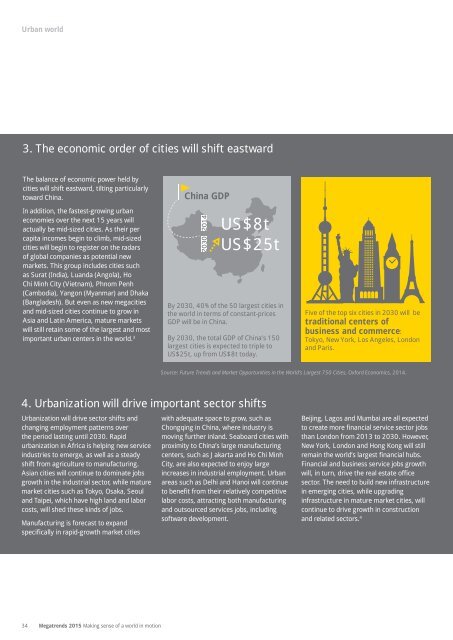ey-megatrends-report-2015
ey-megatrends-report-2015
ey-megatrends-report-2015
Create successful ePaper yourself
Turn your PDF publications into a flip-book with our unique Google optimized e-Paper software.
Urban world<br />
3. The economic order of cities will shift eastward<br />
The balance of economic power held by<br />
cities will shift eastward, tilting particularly<br />
toward China.<br />
In addition, the fastest-growing urban<br />
economies over the next 15 years will<br />
actually be mid-sized cities. As their per<br />
capita incomes begin to climb, mid-sized<br />
cities will begin to register on the radars<br />
of global companies as potential new<br />
markets. This group includes cities such<br />
as Surat (India), Luanda (Angola), Ho<br />
Chi Minh City (Vietnam), Phnom Penh<br />
(Cambodia), Yangon (Myanmar) and Dhaka<br />
(Bangladesh). But even as new megacities<br />
and mid-sized cities continue to grow in<br />
Asia and Latin America, mature markets<br />
will still retain some of the largest and most<br />
important urban centers in the world. 3<br />
China GDP<br />
US$8t<br />
US$25t<br />
By 2030, 40% of the 50 largest cities in<br />
the world in terms of constant-prices<br />
GDP will be in China.<br />
By 2030, the total GDP of China’s 150<br />
largest cities is expected to triple to<br />
US$25t, up from US$8t today.<br />
Five of the top six cities in 2030 will be<br />
traditional centers of<br />
business and commerce:<br />
Tokyo, New York, Los Angeles, London<br />
and Paris.<br />
Source: Future Trends and Market Opportunities in the World’s Largest 750 Cities, Oxford Economics, 2014.<br />
4. Urbanization will drive important sector shifts<br />
Urbanization will drive sector shifts and<br />
changing employment patterns over<br />
the period lasting until 2030. Rapid<br />
urbanization in Africa is helping new service<br />
industries to emerge, as well as a steady<br />
shift from agriculture to manufacturing.<br />
Asian cities will continue to dominate jobs<br />
growth in the industrial sector, while mature<br />
market cities such as Tokyo, Osaka, Seoul<br />
and Taipei, which have high land and labor<br />
costs, will shed these kinds of jobs.<br />
Manufacturing is forecast to expand<br />
specifically in rapid-growth market cities<br />
with adequate space to grow, such as<br />
Chongqing in China, where industry is<br />
moving further inland. Seaboard cities with<br />
proximity to China’s large manufacturing<br />
centers, such as Jakarta and Ho Chi Minh<br />
City, are also expected to enjoy large<br />
increases in industrial employment. Urban<br />
areas such as Delhi and Hanoi will continue<br />
to benefit from their relatively competitive<br />
labor costs, attracting both manufacturing<br />
and outsourced services jobs, including<br />
software development.<br />
Beijing, Lagos and Mumbai are all expected<br />
to create more financial service sector jobs<br />
than London from 2013 to 2030. However,<br />
New York, London and Hong Kong will still<br />
remain the world’s largest financial hubs.<br />
Financial and business service jobs growth<br />
will, in turn, drive the real estate office<br />
sector. The need to build new infrastructure<br />
in emerging cities, while upgrading<br />
infrastructure in mature market cities, will<br />
continue to drive growth in construction<br />
and related sectors. 4<br />
34 Megatrends <strong>2015</strong> Making sense of a world in motion


